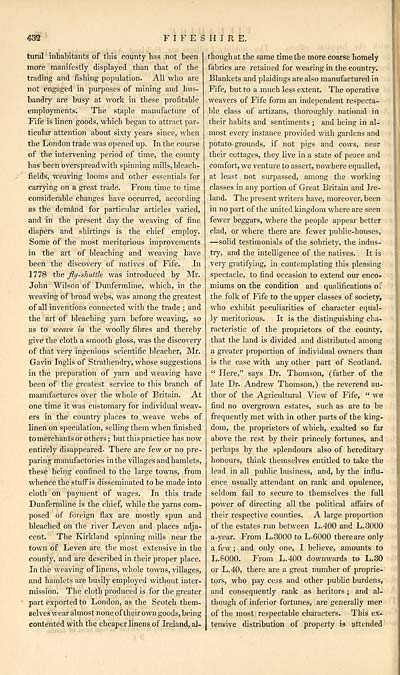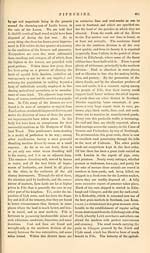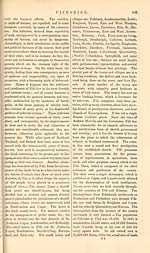Gazetteer of Scotland > Volume 1
(466) Page 432
Download files
Complete book:
Individual page:
Thumbnail gallery: Grid view | List view

432
F I F E S H I R E.
tural inhabitants of this county has not been
more manifestly displayed than that of the
trading and fishing population. All who are
not engaged in purposes of mining and hus-
bandry are busy at work in these profitable
employments. The staple manufacture of
Fife is linen goods, which began to attract par-
ticular attention about sixty years since, when
the London trade was opened up. In the course
of the intervening period of time, the county
has been overspread with spinning mills, bleach-
fields, weaving looms and other essentials for
carrying on a great trade. From time to time
considerable changes have occurred, according
as the demand for particular articles varied,
and in the present day the weaving of fine
diapers and shirtings is the chief employ.
Some of the most meritorious improvements
in the art of bleaching and weaving have
been the discovery of natives of Fife. In
1778 the fly-shuttle was introduced by Mr.
John Wilson of Dunfermline, which, in the
weaving of broad webs, was among the greatest
of all inventions connected with the trade ; and
the art of bleaching yarn before weaving, so
as to weave in the woolly fibres and thereby
give the cloth a smooth gloss, was the discovery
of that very ingenious scientific bleacher, Mr.
Gavin Inglis of Strathendry, whose suggestions
in the preparation of yarn and weaving have
been of the greatest service to this branch of
manufactures over the whole of Britain. At
one time it was customary for individual weav-
ers in the country places to weave webs of
linen on speculation, selling them when finished
tomerchantsor others; but this practice has now
entirely disappeared. There are few or no pre-
paring manufactories in the villages and hamlets,
these being confined to the large towns, from
whence the stuff is disseminated to be made into
cloth on payment of wages. In this trade
Dunfermline is the chief, while the yarns com-
posed of foreign flax are mostly spun and
bleached on the river Leven and places adja-
cent. The Kirkland spinning mills near the
town of Leven are the most extensive in the
county, and are described in their proper place.
In the weaving of linens, whole towns, villages,
and hamlets are busily employed without inter-
mission. The cloth produced is for the greater
part exported to London, as the Scotch them-
selves wear almost n one of their own goods, being
contented with the cheaper linens of Ireland, al-
though at the same time the more coarse homely
fabrics are retained for wearing in the country.
Blankets and plaidings are also manufactured in
Fife, but to a much less extent. The operative
weavers of Fife form an independent respecta-
ble class of artizans, thoroughly national in
their habits and sentiments ; and being in al-
most every instance provided with gardens and
potato- grounds, if not pigs and cows, near
their cottages, they live in a state of peace and
comfort, we venture to assert, nowhere equalled,
at least not surpassed, among the working
classes in any portion of Great Britain and Ire-
land. The present writers have, moreover, been
in no part of the united kingdom where are seen
fewer beggars, where the people appear better
clad, or where there are fewer public-houses,
— solid testimonials of the sobriety, the indus-
try, and the intelligence of the natives. It is
very gratifying, in contemplating this pleasing
spectacle, to find occasion to extend our enco-
miums on the condition and qualifications of
the folk of Fife to the upper classes of society,
who exhibit peculiarities of character equal-
ly meritorious. It is the distinguishing cha-
racteristic of the proprietors of the county,
that the land is divided and distributed among
a greater proportion of individual owners than
is the case with any other part of Scotland.
" Here," says Dr. Thomson, (father of the
late Dr. Andrew Thomson,) the reverend au-
thor of the Agricultural View of Fife, " we
find no overgrown estates, such as are to be
frequently met with in other parts of the king-
dom, the proprietors of which, exalted so far
above the rest by their princely fortunes, and
perhaps by the splendours also of hereditary
honours, think themselves entitled to take the
lead in all public business, and, by the influ-
ence usually attendant on rank and opulence,
seldom fail to secure to themselves the full
power of directing all the political affairs of
their respective counties. A large proportion
of the estates run between L.400 and L.3000
a-year. From L.3000 to L.6000 there are only
a few ; and only one, I believe, amounts to
L.8000. From L.400 downwards to L.30
or L.40, there are a great number of proprie-
tors, who pay cess and other public burdens,
and consequently rank as heritors ; and al-
though of inferior fortunes, are generally mer
of the most respectable characters. This ex-
tensive distribution of property is attended
F I F E S H I R E.
tural inhabitants of this county has not been
more manifestly displayed than that of the
trading and fishing population. All who are
not engaged in purposes of mining and hus-
bandry are busy at work in these profitable
employments. The staple manufacture of
Fife is linen goods, which began to attract par-
ticular attention about sixty years since, when
the London trade was opened up. In the course
of the intervening period of time, the county
has been overspread with spinning mills, bleach-
fields, weaving looms and other essentials for
carrying on a great trade. From time to time
considerable changes have occurred, according
as the demand for particular articles varied,
and in the present day the weaving of fine
diapers and shirtings is the chief employ.
Some of the most meritorious improvements
in the art of bleaching and weaving have
been the discovery of natives of Fife. In
1778 the fly-shuttle was introduced by Mr.
John Wilson of Dunfermline, which, in the
weaving of broad webs, was among the greatest
of all inventions connected with the trade ; and
the art of bleaching yarn before weaving, so
as to weave in the woolly fibres and thereby
give the cloth a smooth gloss, was the discovery
of that very ingenious scientific bleacher, Mr.
Gavin Inglis of Strathendry, whose suggestions
in the preparation of yarn and weaving have
been of the greatest service to this branch of
manufactures over the whole of Britain. At
one time it was customary for individual weav-
ers in the country places to weave webs of
linen on speculation, selling them when finished
tomerchantsor others; but this practice has now
entirely disappeared. There are few or no pre-
paring manufactories in the villages and hamlets,
these being confined to the large towns, from
whence the stuff is disseminated to be made into
cloth on payment of wages. In this trade
Dunfermline is the chief, while the yarns com-
posed of foreign flax are mostly spun and
bleached on the river Leven and places adja-
cent. The Kirkland spinning mills near the
town of Leven are the most extensive in the
county, and are described in their proper place.
In the weaving of linens, whole towns, villages,
and hamlets are busily employed without inter-
mission. The cloth produced is for the greater
part exported to London, as the Scotch them-
selves wear almost n one of their own goods, being
contented with the cheaper linens of Ireland, al-
though at the same time the more coarse homely
fabrics are retained for wearing in the country.
Blankets and plaidings are also manufactured in
Fife, but to a much less extent. The operative
weavers of Fife form an independent respecta-
ble class of artizans, thoroughly national in
their habits and sentiments ; and being in al-
most every instance provided with gardens and
potato- grounds, if not pigs and cows, near
their cottages, they live in a state of peace and
comfort, we venture to assert, nowhere equalled,
at least not surpassed, among the working
classes in any portion of Great Britain and Ire-
land. The present writers have, moreover, been
in no part of the united kingdom where are seen
fewer beggars, where the people appear better
clad, or where there are fewer public-houses,
— solid testimonials of the sobriety, the indus-
try, and the intelligence of the natives. It is
very gratifying, in contemplating this pleasing
spectacle, to find occasion to extend our enco-
miums on the condition and qualifications of
the folk of Fife to the upper classes of society,
who exhibit peculiarities of character equal-
ly meritorious. It is the distinguishing cha-
racteristic of the proprietors of the county,
that the land is divided and distributed among
a greater proportion of individual owners than
is the case with any other part of Scotland.
" Here," says Dr. Thomson, (father of the
late Dr. Andrew Thomson,) the reverend au-
thor of the Agricultural View of Fife, " we
find no overgrown estates, such as are to be
frequently met with in other parts of the king-
dom, the proprietors of which, exalted so far
above the rest by their princely fortunes, and
perhaps by the splendours also of hereditary
honours, think themselves entitled to take the
lead in all public business, and, by the influ-
ence usually attendant on rank and opulence,
seldom fail to secure to themselves the full
power of directing all the political affairs of
their respective counties. A large proportion
of the estates run between L.400 and L.3000
a-year. From L.3000 to L.6000 there are only
a few ; and only one, I believe, amounts to
L.8000. From L.400 downwards to L.30
or L.40, there are a great number of proprie-
tors, who pay cess and other public burdens,
and consequently rank as heritors ; and al-
though of inferior fortunes, are generally mer
of the most respectable characters. This ex-
tensive distribution of property is attended
Set display mode to: Large image | Transcription
Images and transcriptions on this page, including medium image downloads, may be used under the Creative Commons Attribution 4.0 International Licence unless otherwise stated. ![]()
| Gazetteers of Scotland, 1803-1901 > Gazetteer of Scotland > Volume 1 > (466) Page 432 |
|---|
| Permanent URL | https://digital.nls.uk/97429954 |
|---|
| Description | Volume I: Abbey to Glenartney. |
|---|---|
| Attribution and copyright: |
|
| Description | By Robert Chambers and William Chambers. Glasgow: Blackie & Son, 1838. 2 volumes. |
|---|---|
| Shelfmark | NF.1461.g.7 |
| Additional NLS resources: | |

